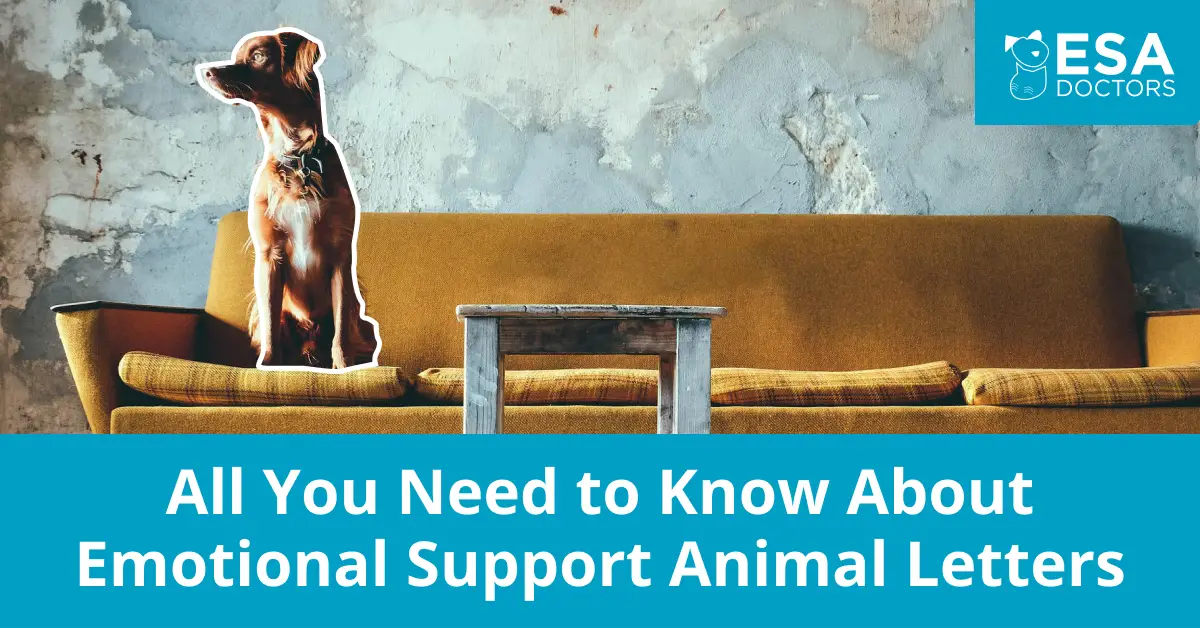Yes, you can have more than one emotional support animal, like two dogs or two cats, and they don’t have to be the same type of animal. Your licensed mental health provider might feel that a dog and a fish or a cat and a bird are able to provide help for different aspects of your condition. Another common situation where you can have more than one emotional support animal in the same house is when there are two or more people living there, and each needs an ESA.
Whatever the case may be, you are allowed to have more than one ESA in your home as long as you meet the document requirements in HUD’s housing rules. You’re exempt from building rules that limit the number of pets you can have if each ESA you have is covered by an ESA Letter.
Whether your ESA is a dog, cat, or one that sports feathers or scales, we’ll explain what you will need to do if you are trying to qualify for more than one ESA in your household. If you are ready to see if you qualify for an emotional support animal, complete the questionnaire using the link below and connect with a licensed mental health professional.
Why do some people need more than one ESA?
There are multiple reasons someone may need more than one emotional support animal, as each animal may have different traits or qualities that alleviate the symptoms of different parts of your mental health issues. Each animal can provide different types of support for various aspects of mental health:
- Different symptoms, different support
Your dog might help reduce depression symptoms by encouraging daily walks and providing unconditional love, while your cat helps calm your anxiety with their gentle purring and peaceful presence. - Complementary benefits
A bird’s cheerful singing might brighten your mood during daytime hours, while a cat’s comforting weight on your lap helps you manage insomnia at night. - Practical assistance
Some people find that a dog helps them maintain routine and feel secure when out in public, while a smaller animal like a rabbit provides comfort during quiet moments at home. - Sensory benefits
The repetitive movement of fish swimming can help ground someone during dissociative episodes, while the soft fur of a cat provides tactile comfort during anxiety attacks. - Emotional connection
Different animals can fulfill various emotional needs – one might provide playful energy when you’re feeling withdrawn, while another offers calm companionship during overwhelming moments.
These situations aren’t unusual, and in fact, HUD’s guidelines recognize that some people will need more than one ESA to deal with their mental or emotional disability.
It is also common for households to have more than one emotional support animal if multiple people have more than one ESA. For example, there may be a home with a husband and wife with different emotional support animals. Or, a home may have roommates who each have their own ESA.
Whatever the reason may be, there is certainly no shame in needing more than one emotional support animal, and it happens more often than you think.

What documents do I need if I have more than one ESA?
To qualify for multiple emotional support animals, you need an ESA letter covering each of your animals.
An ESA letter is a signed document from a mental health professional that recommends an emotional support animal for your mental or emotional disability. The list of conditions that are eligible for an ESA letter includes anxiety, PTSD, autism, and depression.
If you have more than one ESA, the letter must reference each ESA. If you are a household where more than one person has an ESA, each member of the household must have their own ESA letter covering their specific emotional support animal.
If you need a licensed healthcare professional who can qualify you for an ESA letter for multiple animals, ESA Doctors can help. ESA Doctors can pair you with a licensed professional who is knowledgeable about emotional support animals and ESA letters. These licensed professionals are also experienced with situations where more than one ESA is needed. Click here to see why ESA Doctors is your best source for ESA support online.
Is there a limit to how many ESAs I can have?
There’s no specific number limit on how many emotional support animals you can have. Each animal just needs a valid ESA letter from a licensed mental health professional.
But there are practical limits. Your landlord only has to make “reasonable accommodations” under Fair Housing rules. What’s reasonable? It depends on your situation.
Consider these real-world factors:
- Space matters
Do you have enough room for all your ESAs to live comfortably? Three large dogs in a tiny apartment might not be considered reasonable. - Type of animals
Regular household pets like dogs, cats, and small animals are typically accepted. Exotic or unusual animals aren’t. - Safety concerns
Your ESAs can’t create health or safety issues for other tenants or property damage to the building. - Your documented need
Each additional ESA should have a connection to your mental health needs, documented in your ESA letter.
Many people legitimately need multiple ESAs for different aspects of their mental health support, and that’s completely valid. The key is making sure you have proper documentation for each animal to show your landlord.
You can trust ESA Doctors to match you with a real-life professional who is licensed and capable of writing ESA letters.
Complete the questionnaire below to qualify for an ESA:
Get the Love and Support you deserve.





I am a landlord. I require tenants to submit proof that their ESA’s rabies vaccinations are up-to-date. One is refusing to do so. What are my options?
That is a reasonable request to make to ensure the health and safety of other residents. Having ESA status does not exempt a dog owner from getting the appropriate vaccinations.
Can an HOA request that the letter from a licensed medical professional for a reasonable accommodation request be updated by a medical professional and resubmitted yearly?
That is not an uncommon request. Landlords are entitled to verify the tenant needs an ESA by confirming they have a current ESA letter. In addition, most LMHPs will not validate a client’s ESA unless they have a recent evaluation and ESA letter on file.
Legally is a landlord allowed to refuse having 7 ESA cats in a one bedroom apartment?
You are allowed to have more than one ESA if each is covered by your ESA letter. Your therapist or doctor must agree that you need each one for your mental health condition. However, there are limits. Landlords can refuse multiple ESAs if it would create unsafe or unsanitary conditions.
Can 1 renter has 2 support dogs for the same reason? Does a support animal have to be potty trained to go outside or can renters use potty pads claiming their support animal is trained?
You might find this link helpful: https://esadoctors.com/how-many-emotional-support-animals-can-you-have/
ESAs should be housebroken but it is possible to have a very young emotional support animal that has not yet fully mastered potty skills yet, in which case the owner might use potty pads during its training.
I moved into a place already having my dog. Since then there has been a significant change in my mental health. And it has been recommended that my current dog become an ESA. It was also recommended that I get a second ESA. How do I handle this if there is a one pet limit where I am living?
ESAs are technically exempt from pet limitations. Your ESA letter must cover and make specific reference to each of your ESAs. You can also be limited if having too many ESAs would create a safety or health issue.
I am looking for an apartment and have 3 dogs. All of which are ESA’s. The documentation from my therapist states that they are crucial for my mental health and my well being. I should be able to have ALL of them in a 2 pet limit apartment correct?
ESAs do not technically count towards pet limits. Housing providers can however limit ESAs if there is a health or safety issues created by the presence of too many animals in a living space.
I have experienced that large ESA dogs urinate in the residence when owners are not aware of this occurring and, therefore, destroy carpet, the padding under the carpet, the plywood under the padding. Additionally, the dogs put animal oils along the walls and generally leave an animal odor throughout a residence. The cost to replace the carpet, padding, plywood, remove oils from walls and remove animal odors is extraordinarily high. The residence is not rentable for the additional time it takes to repair the property. Revenues are lost for months. ESA laws do not allow a landlord to require an animal deposit to help with the costs to repair the residence. Why do landlords have to subsidize the mental health expense of their tenants? This is clearly unfair to property owners.
ESA owners are responsible for all damage caused by their animals. Landlords may be able to deduct repair amounts from the tenant’s general security deposit.
Is it possible to register just one ESA to two different people that live together?
You do not need to register an ESA. The only way to qualify for an ESA is by having an ESA letter from a licensed healthcare professional. It could be possible for each tenant to have their own separate ESA letter from their licensed healthcare professional and share the same ESA.
I have documentation for each of my 3 ESAs and my landlord uses a pet screening company to decide if the animals qualify as ESAs. They have qualified one animal but keep asking for additional supporting documentation for the other 2. They are wanting documentation stating what each of the other 2 animals support (diagnosis). Any advises?? I did not think they could ask for this kind of information??
Landlords are not entitled to know what the tenant’s specific diagnosis is when verifying an ESA accommodation request.
Hello! So I have 2 emotional supper animals (both of which are dogs) that I have had registered for over a year now due to some extreme anxiety and depression. My husband now also has 2 emotional support animals (which are also dogs), that are registered in his own name. He found out that he was infertile and has had a very difficult time dealing with it, along with some previous anxiety (that he has always had). Two of the dogs are huskies (fairly small ones though) and the other 2 are pretty small (corgi and pocket bully). Either way in total we have 4 dogs in 1 rental. They each have the appropriate documentation but I wasn’t sure if there was a max number or if I could get turned away. We are moving to a home that allows a max of 3 pets but wanted to verify I can still have each of the animals.
You are allowed to have more than one ESA in a household, but each ESA must be covered by an ESA letter from a licensed healthcare professional. Registration does not qualify an animal as an emotional support animal. Please see this link for more information on how ESA letters work: https://esadoctors.com/esa-letter/